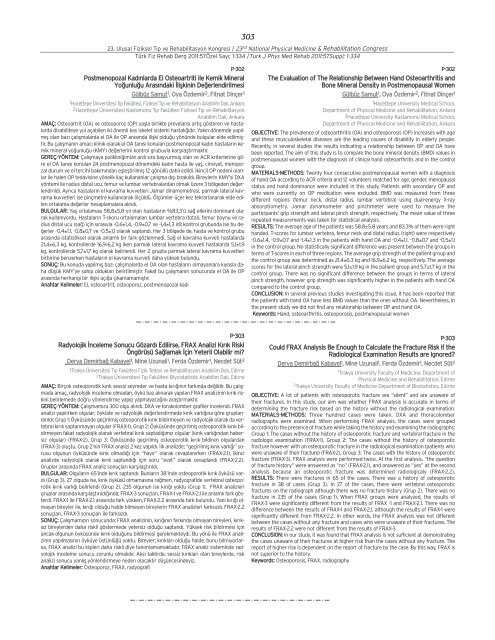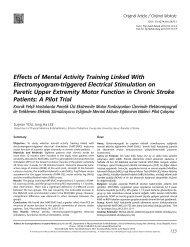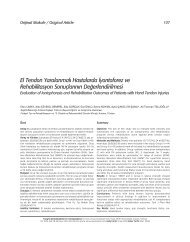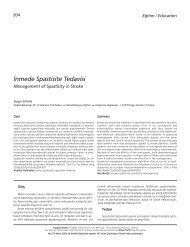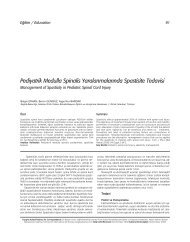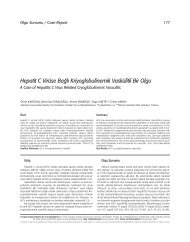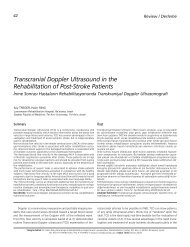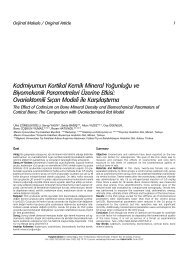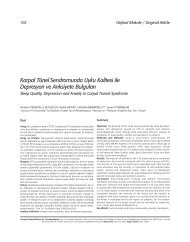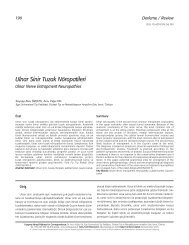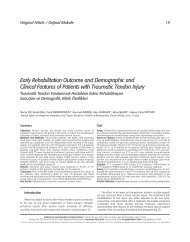Postmenopozal Kad›nlarda Vücut Kitle ‹ndeksinin ... - FTR Dergisi
Postmenopozal Kad›nlarda Vücut Kitle ‹ndeksinin ... - FTR Dergisi
Postmenopozal Kad›nlarda Vücut Kitle ‹ndeksinin ... - FTR Dergisi
You also want an ePaper? Increase the reach of your titles
YUMPU automatically turns print PDFs into web optimized ePapers that Google loves.
P-302<br />
<strong>Postmenopozal</strong> <strong>Kad›nlarda</strong> El Osteoartriti ile Kemik Mineral<br />
Yo¤unlu¤u Aras›ndaki ‹liflkinin De¤erlendirilmesi<br />
Gülbüz Samut 1, Oya Özdemir 2, Fitnat Dinçer 1<br />
1 Hacettepe Üniversitesi T›p Fakültesi, Fiziksel T›p ve Rehabilitasyon Anabilim Dal›, Ankara<br />
2 Hacettepe Üniversitesi Kastamonu T›p Fakültesi Fiziksel T›p ve Rehabilitasyon<br />
Anabilim Dal›, Ankara<br />
AMAÇ: Osteoartrit (OA) ve osteoporoz (OP) yaflla birlikte prevelans› art›fl gösteren ve hastalarda<br />
disabiliteye yol açabilen iki önemli kas iskelet sistemi hastal›¤›d›r. Yak›n dönemde yap›lm›fl<br />
olan baz› çal›flmalarda el OA ile OP aras›nda iliflki oldu¤u yönünde bulgular elde edilmifltir.<br />
Bu çal›flman›n amac› klinik olarak el OA tan›s› konulan postmenopozal kad›n hastalar›n kemik<br />
mineral yo¤unlu¤u (KMY) de¤erlerini kontrol grubuyla karfl›laflt›rmakt›r.<br />
GEREÇ-YÖNTEM: Çal›flmaya poliklini¤imize ard› s›ra baflvurmufl olan ve ACR kriterlerine göre<br />
el OA tan›s› konulan 24 postmenopozal dönemdeki kad›n hasta ile yafl, cinsiyet, menopozal<br />
durum ve el tercihi bak›m›ndan efllefltirilmifl 12 gönüllü dahil edildi. ‹kincil OP nedeni olanlar<br />
ile halen OP tedavisine yönelik ilaç kullananlar çal›flma d›fl› b›rak›ld›. Bireylerin KMY’si DXA<br />
yöntemi ile radius distal ucu, femur ve lumbar vertebralardan olmak üzere 3 bölgeden de¤erlendirildi.<br />
Ayr›ca hastalar›n el kavrama kuvvetleri Jamar dinamometresi, parmak lateral kavrama<br />
kuvvetleri ise pinçmetre kullan›larak ölçüldü. Ölçümler üçer kez tekrarlanarak elde edilen<br />
ortalama de¤erler hesaplamalara al›nd›.<br />
BULGULAR: Yafl ortalamas› 58,8±5,8 y›l olan hastalar›n %83,3’ü sa¤ ellerini dominant olarak<br />
kullan›yordu. Hastalar›n T-skoru ortalamalar› lumbar vertebra (total), femur boynu ve radius<br />
distal ucu (sa¤) için s›ras›yla -0,6±1,4, -0.9±0,7 ve -1,4±1,3 idi; kontrol grubunda ise bu de-<br />
¤erler -0,4±1,1, -0,8±0,7 ve -0,5±1,1 olarak saptand›. Her 3 bölgede de, hasta ve kontrol grubu<br />
aras›nda istatistiksel olarak anlaml› bir fark gözlenmedi. Sa¤ el kavrama kuvveti hastalarda<br />
21,4±6,3 kg, kontrollerde 16,9±6,2 kg iken parmak lateral kavrama kuvveti hastalarda 5,1±1,9<br />
kg, kontrollerde 5,7±1,7 kg olarak belirlendi. Her 2 grupta parmak lateral kavrama kuvvetleri<br />
birbirine benzerken hastalar›n el kavrama kuvveti daha yüksek bulundu.<br />
SONUÇ: Bu konuda yap›lm›fl baz› çal›flmalarda el OA olan hastalar›n olmayanlara k›yasla daha<br />
düflük KMY’ye sahip olduklar› belirtilmifltir. Fakat bu çal›flman›n sonucunda el OA ile OP<br />
aras›nda herhangi bir iliflki a盤a ç›kar›lamam›flt›r.<br />
Anahtar Kelimeler: El, osteoartrit, osteoporoz, postmenopozal kad›<br />
P-303<br />
Radyolojik ‹nceleme Sonucu Gözard› Edilirse, FRAX Analizi K›r›k Riski<br />
Öngörüsü Sa¤lamak ‹çin Yeterli Olabilir mi?<br />
Derya Demirba¤ Kabayel 1, Mine Uzunali 1, Ferda Özdemir 1, Necdet Süt 2<br />
1Trakya Üniversitesi T›p Fakültesi Fizik Tedavi ve Rehabilitasyon Anabilim Dal›, Edirne<br />
2 Trakya Üniversitesi T›p Fakültesi Biyoistatistik Anabilim Dal›, Edirne<br />
AMAÇ: Birçok osteoporotik k›r›k sessiz seyreder ve hasta k›r›¤›n›n fark›nda de¤ildir. Bu çal›flmada<br />
amaç, radyolojik inceleme olmadan, öykü baz al›narak yap›lan FRAX analizinin k›r›k riskini<br />
belirlemede do¤ru yönlendirme yap›p yapmayaca¤›n› araflt›rmakt›r.<br />
GEREÇ-YÖNTEM: Çal›flmam›za 300 olgu al›nd›. DXA ve torakolomber grafiler incelendi. FRAX<br />
analizi yap›l›rken olgular; öyküde ve radyolojik de¤erlendirmede k›r›k varl›¤›na göre grupland›r›ld›:<br />
Grup 1: Öyküsünde geçirilmifl osteoporotik k›r›k bildirmeyen ve radyolojik olarak da vertebral<br />
k›r›k saptanmayan olgular (FRAX-1), Grup 2: Öyküsünde geçirilmifl osteoporotik k›r›k bildirmeyen<br />
fakat radyolojik olarak vertebral k›r›k saptad›¤›m›z olgular (k›r›k varl›¤›ndan habersiz<br />
olgular) (FRAX-2), Grup 3: Öyküsünde geçirilmifl osteoporotik k›r›k bildiren olgulardan<br />
(FRAX-3) olufltu. Grup 2’nin FRAX analizi 2 kez yap›ld›. ‹lk analizde; “geçirilmifl k›r›k varl›¤›” sorusu<br />
olgunun öyküsünde k›r›k olmad›¤› için “hay›r” olarak cevaplan›rken (FRAX-2.1), ikinci<br />
analizde radyolojik olarak k›r›k saptand›¤› için soru “evet” olarak cevapland› (FRAX-2.2).<br />
Gruplar aras›nda FRAX analiz sonuçlar› karfl›laflt›r›ld›.<br />
BULGULAR: Olgular›n 65’inde k›r›k saptand›. Bunlar›n 38’inde osteoporotik k›r›k öyküsü vard›<br />
(Grup 3). 27 olguda ise, k›r›k öyküsü olmamas›na ra¤men, radyografide vertebral osteoporotik<br />
k›r›k varl›¤› belirlendi (Grup 2). 235 olgunun ise k›r›¤› yoktu (Grup 1). FRAX analizleri<br />
gruplar aras›nda karfl›laflt›r›ld›¤›nda; FRAX-3 sonuçlar›, FRAX-1 ve FRAX-2.1 ile anlaml› fark gösterdi.<br />
FRAX-1 ile FRAX-2.1 aras›nda fark yokken, FRAX-2.2 aras›nda fark bulundu. Yani k›r›¤› olmayan<br />
bireyler ile, k›r›¤› oldu¤u halde bilmeyen bireylerin FRAX analizleri farks›zd›. FRAX-2.2<br />
sonuçlar›, FRAX-3 sonuçlar› ile farks›zd›.<br />
SONUÇ: Çal›flmam›z›n sonucunda; FRAX analizinin, k›r›¤›n›n fark›nda olmayan bireyleri, k›r›ks›z<br />
bireylerden daha riskli göstermede yetersiz oldu¤u saptand›. Yüksek risk bildirmesi için<br />
ancak olgunun öyküsünde k›r›k oldu¤unu bildirmesi gerekmekteydi. Bu yönü ile FRAX analizinin<br />
yap›lmas›n›n öyküye üstünlü¤ü yoktu. Bireyler; k›r›klar› oldu¤u halde, bunu bilmiyorlarsa,<br />
FRAX analizi bu kiflileri daha riskli diye tan›mlamamaktad›r. FRAX analiz sisteminde radyolojik<br />
inceleme sonucu zorunlu olmal›d›r. Aksi taktirde, sessiz k›r›klar› olan bireylerde, risk<br />
analizi sonucu yanl›fl yönlendirmeye neden olacakt›r düflüncesindeyiz.<br />
Anahtar Kelimeler: Osteoporoz, FRAX, radyografi<br />
303<br />
23. Ulusal Fiziksel T›p ve Rehabilitasyon Kongresi / 23 rd National Physical Medicine & Rehabilitation Congress<br />
Türk Fiz Rehab Derg 2011:57Özel Say›; 1-334 /Turk J Phys Med Rehab 2011:57Suppl; 1-334<br />
P-302<br />
The Evaluation of The Relationship Between Hand Osteoarthritis and<br />
Bone Mineral Density in Postmenopausal Women<br />
Gülbüz Samut 1, Oya Özdemir 2, Fitnat Dinçer 1<br />
1 Hacettepe University Medical School,<br />
Department of Physical Medicine and Rehabilitation, Ankara<br />
2 Hacettepe University Kastamonu Medical School,<br />
Department of Physical Medicine and Rehabilitation, Ankara<br />
OBJECTIVE: The prevalence of osteoarthritis (OA) and osteoporosis (OP) increases with age<br />
and these musculoskeletal diseases are the leading causes of disability in elderly people.<br />
Recently, in several studies the results indicating a relationship between OP and OA have<br />
been reported. The aim of this study is to compare the bone mineral density (BMD) values in<br />
postmenopausal women with the diagnosis of clinical hand osteoarthritis and in the control<br />
group.<br />
MATERIALS-METHODS: Twenty four consecutive postmenopausal women with a diagnosis<br />
of hand OA according to ACR criteria and 12 volunteers matched for age, gender, menopausal<br />
status and hand dominance were included in this study. Patients with secondary OP and<br />
who were currently on OP medication were excluded. BMD was measured from three<br />
different regions (femur neck, distal radius, lumbar vertebra) using dual-energy X-ray<br />
absorptiometry. Jamar dynamometer and pinchmeter were used to measure the<br />
participants’ grip strength and lateral pinch strength, respectively. The mean value of three<br />
repeated measurements was taken for statistical analysis.<br />
RESULTS: The average age of the patients was 58.8±5.8 years and 83.3% of them were right<br />
handed. T-scores for lumbar vertebra, femur neck and distal radius (right) were respectively<br />
-0.6±1.4, -0.9±0.7 and -1.4±1.3 in the patients with hand OA and -0.4±1.1, -0.8±0.7 and -0.5±1.1<br />
in the control group. No statistically significant difference was present between the groups in<br />
terms of T-scores in each of three regions. The average grip strength of the patient group and<br />
the control group was determined as 21.4±6.3 kg and 16.9±6.2 kg, respectively. The average<br />
scores for the lateral pinch strength were 5.1±1.9 kg in the patient group and 5.7±1.7 kg in the<br />
control group. There was no significant difference between the groups in terms of lateral<br />
pinch strength, however grip strength was significantly higher in the patients with hand OA<br />
compared to the control group.<br />
CONCLUSION: In several previous studies investigating this issue, it has been reported that<br />
the patients with hand OA have less BMD values than the ones without OA. Nevertheless, in<br />
the present study we did not find any relationship between OP and hand OA.<br />
Keywords: Hand, osteoarthritis, osteoporosis, postmenopausal women<br />
P-303<br />
Could FRAX Analysis Be Enough to Calculate the Fracture Risk if the<br />
Radiological Examination Results are Ignored?<br />
Derya Demirba¤ Kabayel 1, Mine Uzunali 1, Ferda Özdemir 1, Necdet Süt 2<br />
1 Trakya University Faculty of Medicine, Department of<br />
Physical Medicine and Rehabilitation, Edirne<br />
2 Trakya University Faculty of Medicine Department of Biostatistics, Edirne<br />
OBJECTIVE: A lot of patients with osteoporotic fracture are “silent” and are unaware of<br />
their fractures. In this study, our aim was whether FRAX analysis is accurate in terms of<br />
determining the fracture risk based on the history without the radiological examination.<br />
MATERIALS-METHODS: Three hundred cases were taken. DXA and thoracolomber<br />
radiographs were examined. When performing FRAX analysis, the cases were grouped<br />
according to the presence of fracture while taking the history and examining the radiographs:<br />
Group 1: The cases without the history of osteoporotic fracture and vertebral fracture in the<br />
radiologic examination (FRAX-1), Group 2: The cases without the history of osteoporotic<br />
fracture however with an osteoporotic fracture in the radiological examination (patients who<br />
were unaware of their fracture) (FRAX-2), Group 3: The cases with the history of osteoporotic<br />
fracture (FRAX-3). FRAX analysis were performed twice. At the first analysis, “the question<br />
of fracture history” were answered as “no” (FRAX-2.1), and answered as “yes” at the second<br />
analysis because an osteoporotic fracture was determined radiologicaly (FRAX-2.2).<br />
RESULTS: There were fractures in 65 of the cases. There was a history of osteoporotic<br />
fracture in 38 of cases (Grup 3). In 27 of the cases, there were vertebral osteoporotic<br />
fractures on the radiograph although there was no fracture history (Grup 2). There was no<br />
fracture in 235 of the cases (Grup 1). When FRAX groups were analyzed, the results of<br />
FRAX-3 were significantly different from the results of FRAX -1 and FRAX-2.1. There was no<br />
difference between the results of FRAX-1 and FRAX-2.1, although the results of FRAX-1 were<br />
significantly different from FRAX-2.2. In other words, the FRAX analysis was not different<br />
between the cases without any fracture and cases who were unaware of their fractures. The<br />
results of FRAX-2.2 were not different from the results of FRAX-3.<br />
CONCLUSION: In our study, it was found that FRAX analysis is not sufficient at demonstrating<br />
the cases unaware of their fractures at higher risk than the cases without any fracture. The<br />
report of higher risk is dependent on the report of fracture by the case. By this way, FRAX is<br />
not superior to the history.<br />
Keywords: Osteoporosis, FRAX, radiography


